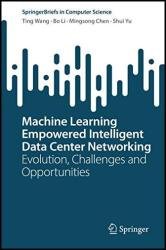 Название: Machine Learning Empowered Intelligent Data Center Networking: Evolution, Challenges and Opportunities
Название: Machine Learning Empowered Intelligent Data Center Networking: Evolution, Challenges and OpportunitiesАвтор: Ting Wang, Bo Li, Mingsong Chen, Shui Yu
Издательство: Springer
Серия: SpringerBriefs in Computer Science
Год: 2023
Страниц: 123
Язык: английский
Формат: pdf (true), epub
Размер: 10.2 MB
An Introduction to the Machine Learning Empowered Intelligent Data Center Networking.
Fundamentals of Machine Learning in Data Center Networks. This book reviews the common learning paradigms that are widely used in data center networks, and offers an introduction to data collection and data processing in data centers. Additionally, it proposes a multi-dimensional and multi-perspective solution quality assessment system called REBEL-3S. The book offers readers a solid foundation for conducting research in the field of AI-assisted data center networks. Comprehensive Survey of AI-assisted Intelligent Data Center Networks. This book comprehensively investigates the peer-reviewed literature published in recent years. The wide range of Machine Learning techniques is fully reflected to allow fair comparisons. In addition, the book provides in-depth analysis and enlightening discussions on the effectiveness of AI in DCNs from various perspectives, covering flow prediction, flow classification, load balancing, resource management, energy management, routing optimization, congestion control, fault management, and network security.
Provides a Broad Overview with Key Insights. This book introduces several novel intelligent networking concepts pioneered by real-world industries, such as Knowledge Defined Networks, Self-Driving Networks, Intent-driven Networks and Intent-based Networks. Moreover, it shares unique insights into the technological evolution of the fusion of Artificial Intelligence and data center networks, together with selected challenges and future research opportunities.
Machine Learning paradigms can be generally classified into three categories: supervised learning, unsupervised learning, and reinforcement learning. With the in-depth research and development of ML, some new learning paradigms such as deep learning and deep reinforcement learning have been derived for more complex scenarios.
Supervised learning is a simple and efficient learning paradigm, but it requires data to be labeled, where the manual labeling task is usually complex and time-consuming with a considerable workload. This learning paradigm is mainly used to finish simple tasks, e.g., fault prediction and flow classification. The typical representative supervised models are random forests, SVM, KNN, and decision trees. Unsupervised learning can mine potential hidden structures in unlabeled datasets but are relatively fragile and sensitive to data quality. It is more prone to the interference of anomalous data, and the final learning effect is difficult to quantify. Therefore, few research works applied unsupervised learning in DCNs.
Compared with the former two learning paradigms, deep learning is differentiated and characterized by the depth of learning, where it is expected to find the intrinsic association among data through continuous iterative feature extraction, convolution, pooling and other necessary operations. CNN, RNN, LSTM, and GRU are the most common deep learning models used in data center networks. Although accompanied by long training time and slow convergence rate which limit its applicability in some scenarios with high real-time requirements, they are widely used owing to their excellent performance.
Unlike the previous models, reinforcement learning is designed to self-learn through continuous interactions with the external environment. The actions performed by the agent can adjust themselves according to the feedback (reward or punishment) given by the environment so as to achieve the global optimal effect. In view of the strong adaptive self-learning ability of reinforcement learning, it has been broadly applied to solve complex problems such as congestion control, routing optimization, and flow scheduling. However, reinforcement learning also has its own problems: (1) The learning model tends to fall into local optimal solutions. (2) The learning model usually requires a long training time, challenging to meet the need of real-time requirements. (3) The learning results may have overfitting phenomenon, which will result in poor model generalization ability in the face of new complex environment.
Deep Learning has strong perception ability, but it lacks certain decision-making ability, while reinforcement learning has decision-making ability, yet it has nothing to do with perception problems. Therefore, deep reinforcement learning is proposed by combining the complementary advantages of two learning paradigms, to enable the model with both perceptual ability and decision-making ability. Unfortunately, deep reinforcement learning still retains the problems of poor stability and complex reward functions.
It can be seen that different learning paradigms have specific limitations, and how to adaptively select appropriate ML models for complex optimization tasks with different objectives in data centers is extremely vital and is much difficult.
Contents:
1. Introduction
2. Fundamentals of Machine Learning in Data Center Networks
3. Machine Learning Empowered Intelligent Data Center Networking
4. Insights, Challenges and Opportunities
5. Conclusion
Скачать Machine Learning Empowered Intelligent Data Center Networking: Evolution, Challenges and Opportunities